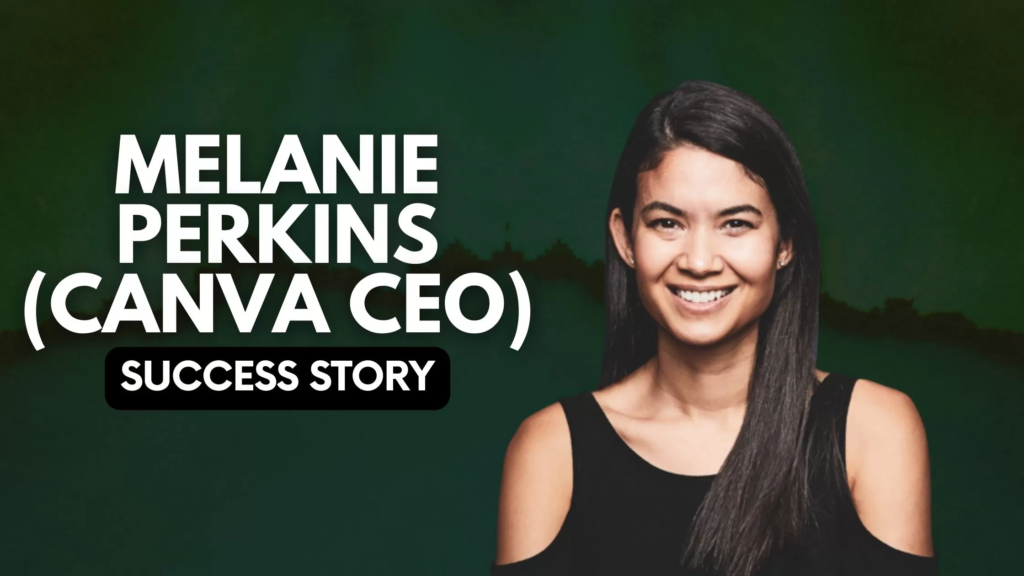From A Design Teacher To An Entrepreneur: A Billon Dollar Story Of “Canva”

The term “entrepreneur” is widely understood in the year 2022, and universities all around the world offer courses in it to help students hone their entrepreneurial talents. Some people even like the word. But, when young “Melanie Perkins” decided to start selling handmade scarves at markets around Perth two decades ago, it was not a popular practice.
However, Perkins has always been enthusiastic about business and got enough support to build a business. As she says, “I never forgot the freedom and excitement of being able to build a business.” That was one of the driving forces that led me to launch what would evolve to be Canva. ”
Melanie Perkins was born in 1988 in Perth, Western Australia, Australia. She was born to multicultural parents: her father is a Malaysian of Filipino and Sri Lankan origin, and her mother was born in Australia. Her father works as an engineer, while her mother is a teacher.
Family and early life

Perkins had already shown an entrepreneurial spirit at a young age. She started her first business when she was 14 years old. She aspired to be a professional skater, even getting up at 4:30 a.m. daily for training sessions. She spent the majority of her childhood at Sacred Heart College before enrolling in college at the University of Western Australia.
Perkins studied communications, psychology, and commerce at the University of Western Australia. As part of her major, she also taught pupils the fundamentals of computer design. After seeing her pupils struggle with Adobe Photoshop and other sophisticated design platforms, she was inspired to create an easier and more efficient graphic design platform. Perkins dropped out of college at the age of 19 to pursue a career in business.
Career
Perkins and her future husband Cliff Obrecht co-founded Fusion Books in 2007. Fusion Books is a platform that enables students to create their own school yearbooks using a drag-and-drop interface and a collection of design templates that includes images, artwork, and fonts. Despite the fact that she had meant to work on her original project, insufficient resources forced her to convert to another, yet Fusion Books nevertheless achieved substantial success.
Perkins began designing Fusion Books at her mother’s house, with her parents assisting with yearbook production. Meanwhile, Obrecht would contact colleges and universities in an attempt to attract new clients for the company. Fusion Books would develop to become Australia’s largest yearbook company in a matter of years, later expanding to France and New Zealand.
The idea of “Canva”
She developed an idea while teaching fellow students basic computer design as part of her communications and business courses. In the age of the internet, the process of designing and publishing a poster or a flyer—composing it in Adobe Photoshop or Microsoft Word, converting it to the correct size and storing it as a PDF, and taking it to a business like Staples to print—seemed time-consuming. Isn’t it much easier to do everything in one spot with one online tool?
“The first concept was to make design incredibly simple,” she explains.
Perkins was afraid that if she waited too long, someone else would solve the problem first. So she hired freelancers to create a Flash website to target one area she identified as consistent and underserved: school yearbooks, which are traditionally handled by student volunteers. Fusion Books, Obrecht and Perkins’ venture, found a market almost immediately. Perkins paused her studies with one semester left in college. Perkins’ mother fed the printers ink overnight during high season. Obrecht cold-called potential customers. Obrecht merely lowered his voice when schools wanted to speak with a manager. The company soon expanded to 400 schools, with licensees as far away as France. It was a beginning. But Perkins couldn’t go much further without venture capital, which was difficult to come by in Perth, a city focused on mining and petrochemicals.
A taste of disappointment
Perkins and Cliff Obrecht wanted to expand on what they’d done with Fusion Books in 2011. Canva’s concept was simple: empower users to make any design they wanted. Wedding invitations, business cards, social media posts, eBooks, and other materials were included (without needing a degree in graphic design).
The online digital design platform was template-based and simple to use, which solved a significant problem for anyone who needed to design something but had the necessary skills. Canva altered the standards for producing high-quality designs by making this service available for free.
However, investors were not convinced. Perkins and Obrecht were dismissed more than 100 times. “Rejection is painful, but failure was never an option… For better or worse, I don’t give up easy when I set my mind to something. “Being rejected a lot in our early stages only meant I had to work harder and tweak my strategy,” Perkins said in a speech about failure and how to grow from it hosted by Blackbird Ventures.
Melanie Perkins refuses to give up despite the frequent rejection. There was nothing she wouldn’t do to help her company succeed, even learning to kitesurf.
Read Full Article: From A Design Teacher To An Entrepreneur: A Billon Dollar Story Of “Canva”

Comments
Post a Comment